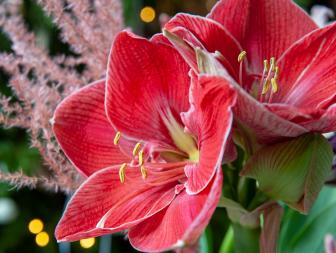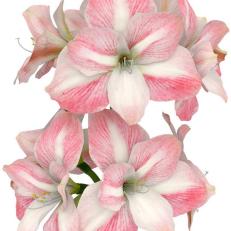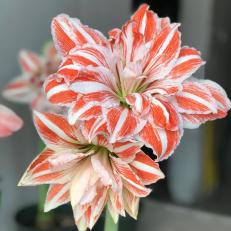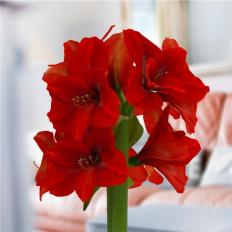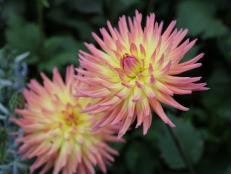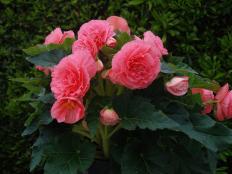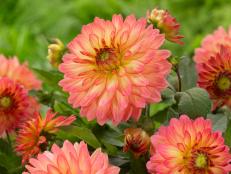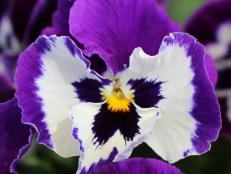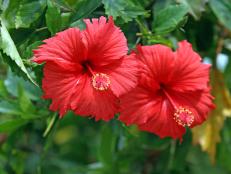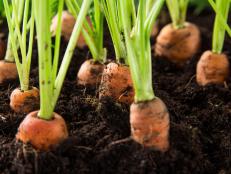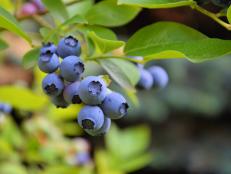How to Grow and Care For Amaryllis
Beautiful but easy, amaryllis bulbs bring the color — indoors and out. Discover different types of amaryllis, including hardy garden varieties and stunning indoor bloomers.
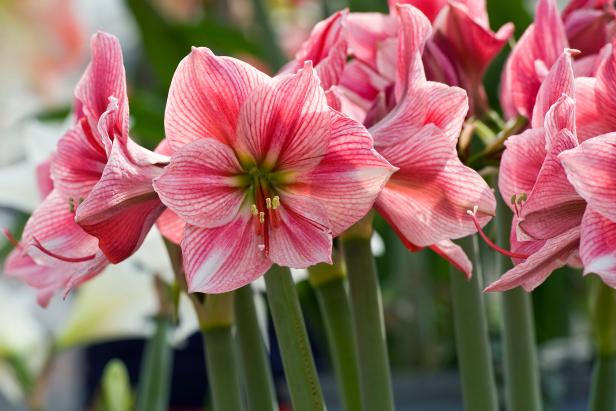
iBulb.org
For sheer flower power, it’s tough to beat amaryllis. Typically sold around the holidays, these baseball-size bulbs unfurl large, trumpet-shaped flowers atop 1- to 2-foot-tall stems. It’s the perfect gift for gardeners of all skill levels, whether new plant parent or experienced greenthumb.
Red and white are the most popular amaryllis flower colors, but you can find varieties in many shades, including pink, orange, rose and deep burgundy. Some blossoms feature two hues — white petals edged in red, for instance. Others are striped with several tints, such as green, pink, red or burgundy.
20 Stunning Amaryllis Varieties 20 Photos
Explore the many beautiful amaryllis varieties you can grow or give as holiday gifts.
Amaryllis bulbs for indoor use are hybrids developed from plants that are native to Central and South America. These hybrids open blossoms from 4 to 10 inches across in a range of colors.
Growing amaryllis bulbs as houseplants is fun and foolproof. Each bulb delivers a sure-fire flower show that’s spectacular with even the most minimal care. The magic of amaryllis bulbs is that you can literally watch the flower bud grow from day to day. It changes in front of your eyes, from a tiny snout of green poking from the top of the bulb to a ball of flowers balanced atop a slender stem.
You can also find hardy types of amaryllis plants to grow outside, such as St. Joseph’s lily (Hippeastrum x johnsonii; hardy in Zones 7-10) or belladonna lily (Amaryllis belladonna; hardy in Zones 3-10), also known as naked lady plant.
Whether you’re growing a houseplant or hardy amaryllis plant, all boast fuss-free personalities that thrive without pampering. Learn what you need to know about caring for amaryllis.
Hardy Amaryllis Plants
Hardy St. Joseph’s lily (Hippeastrum x johnsonii) is the oldest hybrid amaryllis. An heirloom plant developed in 1799, this lily is a treasured pass-along plant that's hardy in Zones 7 to 10. Getting your hands on the bulbs is typically the toughest part of growing this beauty. Bulbs are usually only available through bulb companies that specialize in heirloom plants. If you spot it in a neighbor’s yard, ask if you can have a clump. You might also see it at a local plant sale or plant swap.
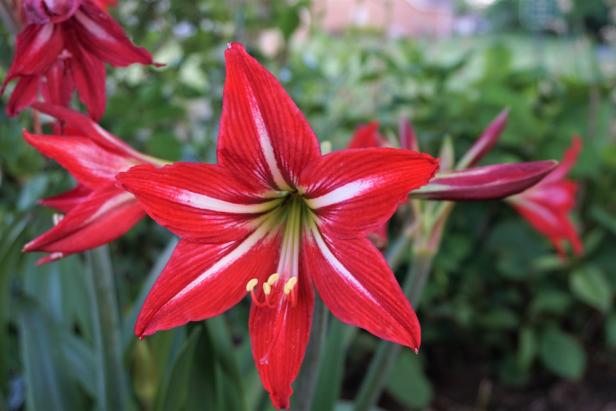
Shutterstock/PT Hamilton
St. Joseph’s lily is hardy in Zones 7-10 and plants form clumps about 24 inches tall. Flowers stand on sturdy stems.
St. Joseph’s lily flowers in late spring, opening red and white bicolor blooms that contrast beautifully with dark green leaves. This amaryllis tends to form clumps that are 18 to 24 inches tall. Flower stems usually grow to about 24 inches — tall enough to stand out against leaves, but short enough not to need staking.
Like all amaryllis plants, belladonna lily (Amaryllis belladonna) grows from a bulb. Look for these amaryllis bulbs for sale from a specialty bulb company or local plant sale. This amaryllis has an unusual growth habit. In fall or even winter in mild regions, it sends up strappy, bright green leaves that fade and disappear as summer heat arrives. About six weeks after leaves vanish, flower stalks rise from the ground, topped with clusters of pink blooms. The flower stems grow alone, unaccompanied by leaves, which has earned these hardy amaryllis the name naked lady plant or resurrection lily.

Julie Martens Forney
Belladonna lily (Amaryllis belladonna) is hardy in Zones 3-10. This perennial amaryllis is also known as naked lady plant or resurrection lily.
Amaryllis Care
Amaryllis in the Garden
Protect St. Joseph’s lily plants from sizzling afternoon sun in warmest regions. In these areas, high, bright shade provides an ideal growing environment for plants to thrive with little supplemental water.
Divide belladonna lily clumps when they’re overcrowded, but otherwise try not to disturb belladonna lilies. If you move them in the garden, they may not flower for a few years. This is the kind of perennial bulb that’s best left alone. It’s a true plant-it-and-forget-it bloomer.
Amaryllis as Houseplants
Place your amaryllis where it will receive bright, indirect light. A table near an east or south window is perfect. Water soil only when it’s dry to the touch one knuckle deep (shove your index finger into soil to test). You won’t need to water as often while the bulb is just starting to grow. Once leaves appear, you’ll water more frequently.
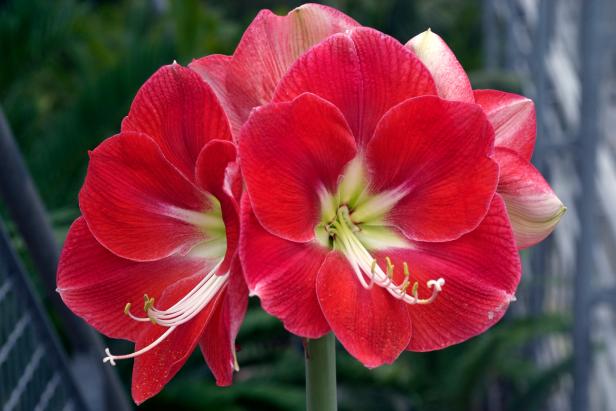
Courtesy of Colorblends.com
Cherry red ‘Monaco’ has a white throat with a green center on each large bloom.
You don’t need to fertilize your amaryllis plant until after flowers fade — and even then, only if you intend to keep the bulb growing from year to year.
Amaryllis is a low-maintenance houseplant that you can keep and grow for decades, or you can compost it after the floral fireworks. If you want to keep your bulb as a houseplant, snip flower stalks at the base after blossoms fade.
Feed plants with a liquid houseplant fertilizer to encourage and nourish leaf production. Healthy leaves in spring and summer are the secret to a pretty flower display the next fall or winter. You can keep amaryllis bulbs indoors year-round, or set them outdoors in spring after all danger of frost is past. Water and fertilize plants through summer.
Potted amaryllis bulbs may send up flower stems first, followed by leaves. Some varieties produce leaves and flowers at the same time. Amaryllis flower stems can be long and lanky, and the pot may become top heavy. It never hurts to drop your amaryllis pot into a larger, heavier container to help keep it upright. You can slip a stake into soil at planting time to help keep blossom stems soldier straight, but that alone won’t cure a top-heavy plant. The weight imbalance still makes it prone to toppling.
Planting Amaryllis
Planting Outdoors
Give St. Joseph’s Lily plant a spot in part- to full-sun with rich, well-drained soil.
Tuck belladonna lily bulbs into rich, well-drained soil in full sun. Choose a planting location where the leaves can grow unobstructed. If you plant it in a grassy area, don’t mow while the leaves are growing because they’re helping to build up food reserves in the bulb that will fuel future flower shows.
If you plant belladonna bulbs into existing flower beds, consider marking the spot so you don’t accidentally try to plant something else there. Because belladonna lily doesn’t have a steady presence in the garden, it’s easy to think you have a bare spot in a planting bed, when in fact you’re just waiting for the flower show to come.
Planting Indoors
Select a pot that’s about 1 inch wider than your amaryllis bulb. It should have drainage holes.
Fill your container with a commercial bagged potting soil that has a high organic matter content (such as coir or peat moss).
Place the bulb into the pot so that one-third to one-half of the amaryllis bulb sticks above soil level. Gently add and tamp soil around the bulb. Water after planting to soak soil.
Amaryllis in the Landscape
Many Southern gardeners count on St. Joseph’s lily to complement a foundation planting or to line a driveway or walk. It’s also a nice companion to flowering shrubs, such as summersweet or gardenia, and you’ll often see it planted beneath palm trees as a ground cover.
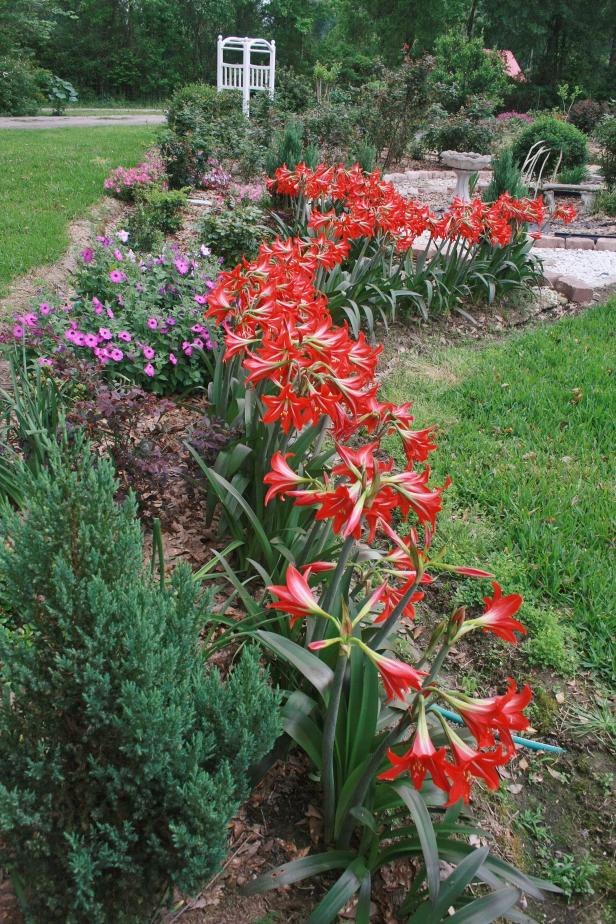
Amaryllis flowers and junipers growing together.
Choosing Amaryllis Bulbs
Start with the biggest amaryllis bulb you can find. Bigger bulbs mean more flower stems. Blossom size depends on variety — some amaryllis blooms are petite, while others are as big as a grapefruit. Flowers open in clusters, creating an eye-catching centerpiece.

iBulb.org
When choosing amaryllis bulbs, look for the biggest you can find — bigger bulbs produce more flower stems. Healthy bulbs should be firm to the touch without any soft spots. A few plump, white roots (not crispy) is another sign of fresh bulbs.
Look for amaryllis bulbs for sale at garden centers, florists, box stores or online. Some companies specialize in top tier amaryllis bulbs — the biggest ones available. These bulbs command a premium price, but they’re worth it.
Buy Bulbs
Healthy amaryllis bulbs are dry and firm to the touch. A visible bud may or may not be peeking from the top of the bulb. If roots are present, look for ones that are plump. If all bulbs have dry, crispy roots, don’t worry. The plant will produce new ones once it’s in soil.
Waxed Amaryllis
Waxed amaryllis bulbs don’t need to be planted. These bulbs are dipped in wax to reduce the need for moisture. When you buy a waxed amaryllis, all you need to do is place the bulb in a spot with some natural light. It doesn’t need to be planted in soil — it can sit on a shelf or in a bowl or basket. The bulb produces a flower stalk and blooms without any water. Once flowers fade, toss the bulb.
Encouraging Amaryllis Flowers
Amaryllis bulbs grown as houseplants (non-hardy types) can’t survive frost. As autumn arrives, begin to cut back on water. If fall is your rainy season, shift plants under a porch or into a shed to let them dry. Amaryllis bulbs can grow continuously, but if you let them go dormant, you can control when the next flowers will appear.
In cold regions, move pots with bulbs indoors to somewhere dark and cool (garage, closet or basement) before frost arrives. Stop watering. Eventually leaves will die back and become crispy. Clip these so that you end up with a bulb sticking out of a pot — much like you had when you started your amaryllis adventure.
Check pots occasionally. When you see new growth, remove the top inch or two of soil and replace with fresh potting mix. It's okay to blend a little slow-release fertilizer into the new soil. Water well, and move your pot to a sunny window. Different amaryllis varieties grow and flower at different rates, but in general, it usually takes four to six (or sometimes eight) weeks for flowers to open from a fully dormant bulb.
As bulbs age, you may need to repot. The best time for repotting amaryllis bulbs is after they have gone through a dormant period.
Amaryllis Varieties
Rosario — This evergreen amaryllis can be grown year-round as a houseplant or outdoors as a landscape plant in Zones 8-11. Look for this amaryllis from specialty bulb growers.
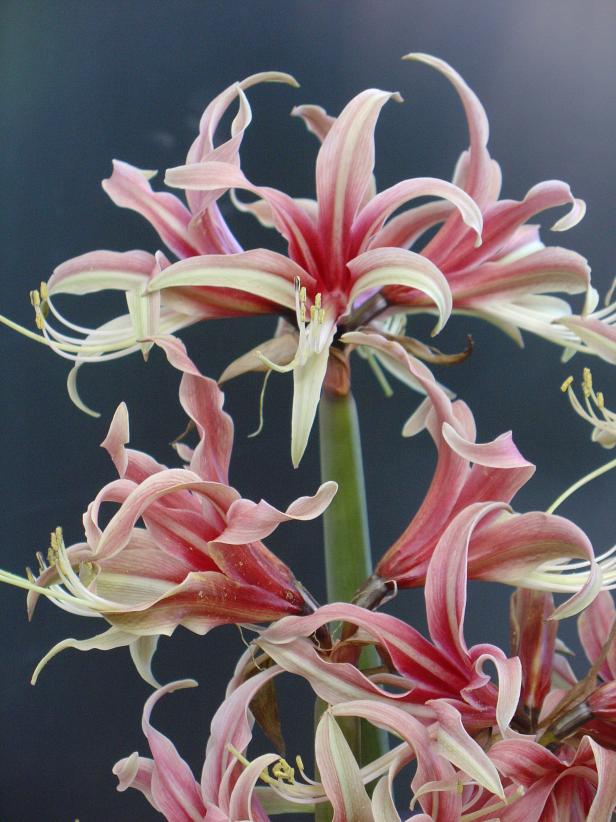
iBulb.org
Rosario can be grown year-round as a houseplant or outdoors as a landscape plant in Zones 8-11.
'Summertime' — This variety's 7-inch blooms range from watermelon pink to deep rose.
'Samba' — 'Samba' averages 20 inches tall with big, red, ruffled blooms with white markings and margins.
'Apple Blossom' — This variety's flowers are a mix of candy pink and snowy white, with lime green throats.

Courtesy of Longfield Gardens
'Apple Blossom' flowers are a mix of candy pink and snowy white with green throats.
'Rilona' — The flowers of this heirloom variety vary in size of 7 to 8 inches across and open in shades of apricot and salmon on stems 12 to 24 inches tall.
Amaryllis Pollen
Amaryllis blossoms resemble lilies, so remember everything you know about lily pollen. Each flower has stamens topped with flat yellow paddles packed with pollen. This pollen can stain clothing, table runners, furniture — anything it drops on. Pollen is oily. The easiest way to remove it from fabric is by lifting it with tape (use the sticky side to lift individual grains). To remove a pollen stain completely, place the fabric in direct sunshine.
If you aren’t able to let the sun remove the stain, pre-treat pollen-stained fabrics with something that targets oily stains. Wash the item solo to make sure the pollen comes out. If you wash it with other fabrics, the pollen can float in the water (oil and water don’t mix) and settle on other clothes.
Amaryllis Propagation
Hardy Amaryllis in the Garden
As hardy amaryllis bulb clumps increase, at some point you’ll probably want to divide the clump to share bulbs with friends or spread them around your landscape. The best time of year to tackle this kind of amaryllis propagation is in fall, after leaves have yellowed.
Dig the clump carefully, freeing only the edges if you just want a few amaryllis bulbs. If you want to divide the entire clump, dig wide enough around your amaryllis that you avoid slicing bulbs. Most amaryllis bulbs separate easily once they’re out of soil.
Transplant them as soon as possible so the fleshy roots don’t dry out. It’s a good idea to dig planting holes and water them prior to lifting the original clump to limit how long bulbs and roots are exposed to air.
Amaryllis as Houseplants
With indoor amaryllis, the easiest way to propagate plants is by bulb offsets — small bulbs that form alongside the original bulb. This occurs with older bulbs only. Many times, you may just want to let the small bulb grow beside the older one for a few years until it gains some size. It won't bloom right away. Usually it takes two to three years for a new bulb to mature enough to form a flower bud.
If you let small bulbs continue to grow with the larger bulb, you'll eventually have a pot full of amaryllis, which yields a miniature flower garden when they bloom.
Amaryllis Propagation by Saving Seeds
Some hardy amaryllis bulbs produce viable seed that you can save and germinate. Amaryllis seed often comes from hybrid bulbs, which means the seeds produce plants that won’t be 100 percent similar to either parent plant. Instead, you might create a wonderful flower color by sprouting and growing amaryllis seeds.
When hardy amaryllis flower, the blooms can be pollinated. Insects might accomplish the task, or you might do it by hand. However flowers are pollinated, when they fade they form seed pods. Amaryllis seed pods are fleshy, plump structures that hang on at the end of the tall flower stalks.
It usually takes amaryllis seed pods anywhere from four to six weeks to ripen. It’s best to let them go through the ripening process while still attached to the plant. Pods are ripe when they turn yellow and start to open. Amaryllis seed pods open to reveal tight stacks of black, papery seeds.
Once seed pods split, you can harvest the seeds. It’s usually easiest to snip the pod free from the plant and open it over a sheet of plain paper. That way, the seeds are easy to spot. When you clip the pod free, go ahead and cut the flower stalk back to the base. Add the stalk to your compost pile.
Let seeds dry a few days on a sheet of paper. Amaryllis seeds are light and easily shifted by puffs of air, so take care where you place your seeds while they dry. Some gardeners like to sow amaryllis seeds in soil; others sprout them by floating seeds in water.
If you choose the soil route, don’t use garden soil or even potting soil. Buy a bag of commercial germinating mix or seed starting mix. Fill your seed-starting container with the mix and moisten it before adding seeds. Then sprinkle seeds over soil, pressing them gently against the damp mix. Barely cover amaryllis seeds with more germinating mix and spritz with water until you soak the top layer of mix.
Some gardeners plant the seeds on edge, so that they’re sticking out of the germinating mix. If you use this method, sow them into a container with a lid so you can create a humid environment around the amaryllis seeds. If you sprout seeds in water, once roots appear, transfer the seeds to a germinating mix, barely covering them.
It takes anywhere from three to 14 years for a seed-sprouted amaryllis to flower. Patience is the key when growing amaryllis seeds. Some hardy amaryllis, like St. Joseph’s lily, produce sterile seeds that won’t sprout. You’ll know if other seeds are viable by gently feeling them. If you feel a plump kernel in one part of the papery seed, that’s likely an embryo and will sprout.
Amaryllis Problems
Amaryllis isn't really bothered by pests or diseases. The most common problem is overwatering potted amaryllis, which leads to bulb rot.
Hardy landscape amaryllis can develop a disease known as red blotch or leaf scorch. It shows up as red spots or streaks on leaves and the bulb. Usually it forms on plants grown in the shade and irrigated frequently. This fungal disease is very difficult to control. Infested bulbs should be dug up and destroyed.

.-Battle-on-the-Beach-courtesy-of-HGTV.-.jpg.rend.hgtvcom.196.196.suffix/1714761529029.jpeg)





